
The Special Air Service Regiment, officially abbreviated SASR though commonly known as the SAS, is a special forces unit of the Australian Army. Formed in 1957 as a company, it was modelled on the British SAS with which it shares the motto, "Who Dares Wins". Expanded to a regiment in August 1964, it is based at Campbell Barracks, in Swanbourne, a suburb of Perth, Western Australia, and is a direct command unit of the Special Operations Command.
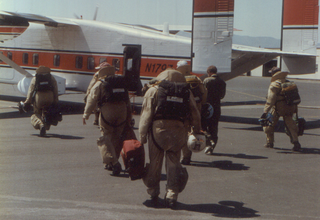
Smokejumpers are specially trained wildland firefighters who provide an initial attack response on remote wildfires. They are inserted at the site of the fire by parachute. This allows firefighters to access remote fires in their early stages without needing to hike long distances carrying equipment and supplies. Traditional terrestrial crews can use only what they can carry and often require hours and days to reach fire on foot. The benefits of smokejumping include the speed at which firefighters can reach a burn site, the broad range of fires a single crew can reach by aircraft, and the larger equipment payloads that can be delivered to a fire compared to pedestrian crews.
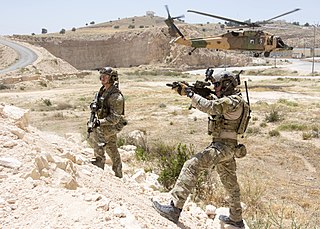
Special operations or spec ops are military activities conducted, according to NATO, by "specially designated, organized, selected, trained, and equipped forces using unconventional techniques and modes of employment." Special operations may include reconnaissance, unconventional warfare, and counterterrorism, and are typically conducted by small groups of highly trained personnel, emphasizing sufficiency, stealth, speed, and tactical coordination, commonly known as special forces.
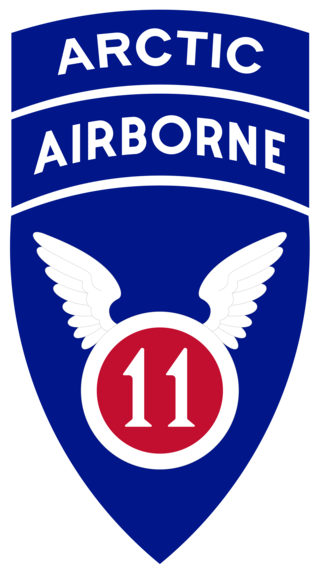
The 11th Airborne Division is a United States Army airborne formation based in Alaska.

Force Reconnaissance (FORECON) are United States Marine Corps deep reconnaissance companies that supply military intelligence to the command element of the Marine Air-Ground Task Force (MAGTF). Force Reconnaissance companies unlike USMC division reconnaissance report to the Marine expeditionary force (MEF) and provide direct action and deep reconnaissance during large-scale operations.

The Ranger School is a 62-day United States Army small unit tactics and leadership course that develops functional skills directly related to units whose mission is to engage the enemy in close combat and direct fire battles. Ranger training was established in September 1950 at Fort Benning, Georgia. The Ranger course has changed little since its inception. Until recently, it was an eight-week course divided into three phases. The course is now 61 days in duration and divided into three phases as follows: Benning Phase, Mountain Phase, and Swamp Phase.

Jungle warfare or woodland warfare is warfare in forests, jungles, or similar environments. The term encompasses military operations affected by the terrain, climate, vegetation, and wildlife of densely-wooded areas, as well as the strategies and tactics used by military forces in these situations and environments.
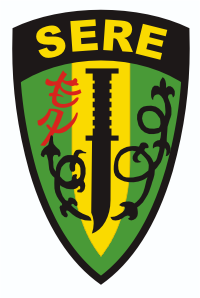
Survival, Evasion, Resistance, and Escape (SERE) is a training program, best known by its military acronym, that prepares U.S. military personnel, U.S. Department of Defense civilians, and private military contractors to survive and "return with honor" in survival scenarios. The curriculum includes survival skills, evading capture, application of the military code of conduct, and techniques for escape from captivity. Formally established by the U.S. Air Force at the end of World War II and the start of the Cold War, it was extended to the Navy and United States Marine Corps and consolidated within the Air Force during the Korean War (1950–1953) with greater focus on "resistance training".

The Paramarines was a short-lived specialized combat unit of the United States Marine Corps, trained to be paratroopers dropped from planes by parachute. Marine parachute training which began in New Jersey in October 1940 ended with the parachute units being disbanded at Camp Pendleton, California in February 1944. Paratroopers received a significantly increased salary after completing training, so there was no shortage of volunteers, although all were required to be unmarried. Standards of fitness were high, and 40% failed the training course.
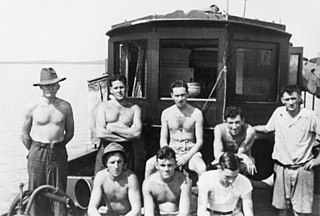
Z Special Unit was a joint Allied special forces unit formed during the Second World War to operate behind Japanese lines in South East Asia. Predominantly Australian, Z Special Unit was a specialist reconnaissance and sabotage unit that included British, Dutch, New Zealand, Timorese and Indonesian members, predominantly operating on Borneo and the islands of the former Dutch East Indies.
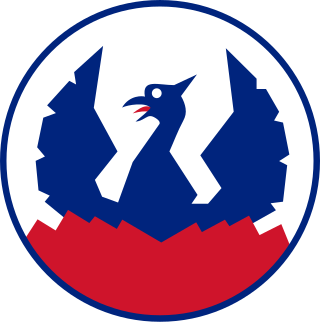
Force 136 was a far eastern branch of the British World War II intelligence organisation, the Special Operations Executive (SOE). Originally set up in 1941 as the India Mission with the cover name of GSI(k), it absorbed what was left of SOE's Oriental Mission in April 1942. The man in overall charge for the duration of its existence was Colin Mackenzie.

The 3rd Battalion, Royal Australian Regiment is a mechanised infantry battalion of the Australian Army, based in Kapyong Lines, Townsville as part of the 3rd Brigade. 3 RAR traces its lineage to 1945 and has seen operational service in Japan, Korea, Malaya, Borneo, South Vietnam, Rifle Company Butterworth, East Timor, the Solomon Islands, Afghanistan and Iraq.

RAAF Base Rathmines is a heritage-listed former RAAF Second World War seaplane base and now used as community venues, sports venues and a visitor attraction at Dorrington Road, Rathmines, City of Lake Macquarie, New South Wales, Australia. It was in use as an RAAF base from 1939 to 1961. It is also known as Rathmines Park, former RAAF Seaplane Base, Flying Boat Base, Rathmines Aerodrome and Catalina Base. The property is owned by Australian Christadelphian Bible School, Disability Life Enrichment, Don Geddes Nursing Home and Lake Macquarie City Council. The remains of the former air base was added to the New South Wales State Heritage Register on 25 November 2005.

Camp Blanding Joint Training Center is the primary military reservation and training base for the Florida National Guard, both the Florida Army National Guard and certain nonflying activities of the Florida Air National Guard. The installation is located in Clay County, Florida, near the city of Starke in adjacent Bradford County. However, while Camp Blanding utilizes a Starke address, it is located totally within the confines of Clay County. The site measures about 73,000 acres (30,000 ha) and includes Kingsley Lake. It also hosts other Reserve, Army National Guard, Air National Guard, and some Active Component training for the U.S. Armed Forces.

The Pasukan Khas TUDM – it is better known as PASKAU – is the special operations force of the Royal Malaysian Air Force. Its main functions are to carry out high-value target protection, ground forward air controller, combat search and rescue and rescuing downed aircrew assignments. PASKAU is also tasked as the principal anti-hijack response force for military and civil aircraft in Malaysia. This task was taken over from Grup Gerak Khas. All PASKAU members are airborne and commando-trained and can be deployed behind enemy lines via air, land and sea to assist in target designation for the Malaysian Armed Forces and RMAF missions.
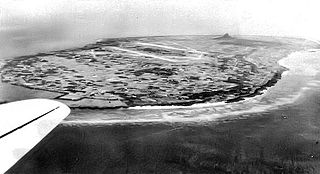
Ie Shima Auxiliary Airfield is a training facility, managed by the United States Marine Corps and a former World War II airfield complex on Ie Shima, an island located off the northwest coast of Okinawa Island in the East China Sea. The airfield as such was inactivated after 1946 but part of the former airfield is still used as a training facility for parachute drops and vertical take off and landing aircraft such as the F-35. The facility is referenced as FAC6005 by Okinawa Prefecture.

Special forces or special operations forces (SOF) are military units trained to conduct special operations. NATO has defined special operations as "military activities conducted by specially designated, organized, selected, trained and equipped forces using unconventional techniques and modes of employment".

The Z Experimental Station (ZES) was established in July 1942 at Munro Terrace, Mooroobool, Cairns, Queensland, Australia, jointly by Secret Intelligence Australia and the Inter-Allied Services Department. The building chosen to be the headquarters was known as "Fairview", and it had been the home of Richard Ash Kingsford, the first mayor of Cairns and grandfather of aviator Sir Charles Kingsford Smith.
Operation Agas was a series of reconnaissance operations carried out by Australia's Z Special Unit in 1945 during the final stages of World War II. This operation was part of the Borneo Campaign, supporting Allied operations to secure North Borneo. Another closely related operation codenamed Semut was carried out in Sarawak. Both operations combined and relayed their intelligence through the Stallion Project to Australian forces and carried out guerrilla warfare against the Japanese in the region with support of the local population. A total of five operations were undertaken, commencing in March 1945, continuing up to September and October 1945.


















